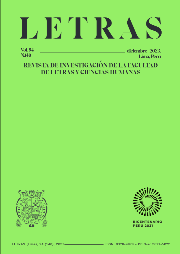Urban patterns of social interaction: Models of Lima and Mexico City versus Georg Simmel’s ideal type
Abstract
Based on the case of Berlin at the end of the 19th century, Georg Simmel argues that overexposure to influences from modern urban environment, in addition to depersonalization and rationalization of life under monetary economy, operate to produce a type of subject characterized by an individualistic, indifferent and reserved attitude that enhance intellectual traits. This model has been used in Latin American urban studies, where, however, the predominant social types are very different. This paper presents ethnographic observations and materials from various sources about some cultural patterns of social interaction in Lima and Mexico City, with a focus on conceptions of time and everyday ways of managing agreements. Thus, it is shown that, in these cities, the predominant social type is one that values reciprocity and warmth in social relations, and that in various fields acts guided by affections, senses and traditional ideals, contrasting in these and other aspects with the Simmel’s archetype. On this basis, it is discussed how the uncritical use of theoretical schemes can contribute to the reproduction of prejudices and stereotypes about Latin Americans.Downloads
Métricas alternativas
References
Ateca-Amestoy, V., Aguilar, A. C. y Moro-Egido, A. I. (2014). Social interactions and life satisfaction: Evidence from Latin America. Journal of Happiness Studies, 15(3), 527-554. https://doi.org/10.1007/s10902-013-9434-y
Bartra, R. (Ed.). (2013). Anatomía del mexicano. Penguin Random House.
Bruce, J. (2014, 17 de marzo). Júntala nomás. En La República (Lima).
Diaz-Guerrero, R. (1959). Mexican assumptions about interpersonal relations. ETC: A Review of General Semantics, 16(2), 185-188.
Duarte, F. (2011). The strategic role of charm, simpatia and jeitinho in Brazilian society: A qualitative study. Asian Journal of Latin American Studies, 24(3), 29-48. http://
www.ajlas.org/v2006/paper/2011vol24no302.pdf
Estenssoro J. C., Romero, P., Wuffarden, L. E. y Majluf, N. (2000). Los cuadros de mestizaje del virrey Amat: La representación etnográfica en el Perú colonial. Museo de Arte de Lima.
Mumford, L. (1992 [1934]). Técnica y civilización. Alianza.
Privitera, M. y Perelman, M. (2021). Georg Simmel: Vida urbana y personalidad. En V. Paiva (Comp.), Sociología y vida urbana: De los clásicos a los problemas actuales (pp. 45-64). Universidad de Buenos Aires.
Quijano, A. (1993). Colonialidad del poder, eurocentrismo y América Latina. En E. Lander (Comp.), La colonialidad del saber: Eurocentrismo y ciencias sociales (pp. 201-246). Consejo Latinoamericano de Ciencias Sociales. https://doi.org/10.30920/letras.94.140.8
Randall, R. (2018). Cordiality and intimacy in contemporary Brazilian culture: Introduction. Journal of Iberian and Latin American Studies, 24(3), 295-310. https://doi.org/10.1080/14701847.2018.1531224
Redfield, R. (2008). Mexicanos en Chicago: Diario de campo de Robert Redfield 1924-1925. Universidad de Guadalajara, Porrúa, El Colegio de San Luis.
Reulecke, J. (1977). Population growth and urbanization in Germany in the 19th century. Urbanism Past & Present, 4, 21-32.
Rodríguez, D. (2020, 15 de oct.). “Yo te aviso” y otras formas que tienen los mexicanos de decir que no (sin decirlo). El País-Lo Mejor de Verne (España). https://verne.elpais.com/verne/2020/10/14/mexico/1602705646_007863.html
Rojas, A. G. (2019, 12 de sept.). ¿Por qué a los mexicanos les cuesta tanto decir que no? BBC News Mundo. https://www.bbc.com/mundo/noticias-49173974
Sabido Ramos, O. (Coord.). (2007). Georg Simmel: Una revisión contemporánea. Anthropos, Universidad Autónoma Metropolitana-Azcapotzalco.
Sabido Ramos, O. (2017). The senses as a resource of meaning in the construction of the Stranger: An approach from Georg Simmel’s relational sociology. Simmel Studies, 21(1), 15-41. https://doi.org/doi.org/10.7202/1041335ar
Sabido Ramos, O. (2020). La proximidad sensible y el género en las grandes urbes: Una perspectiva sensorial. Estudios Sociológicos, 38(112), 201-231. https://doi.org/10.24201/es.2020v38n112.1763
Santos, M. A. dos. (2008). A arena cultural paulistana: Um olhar sobre as condições de implementação do modernismo na São Paulo do início do século XX. Oculum Ensaios, 7/8, 14-23. https://periodicos.puc-campinas.edu.br/oculum/article/view/358
Segura, R., y Cingolani, J. (2020). Georg Simmel y la vida urbana: Dinero, anonimato, moda y estigmas. En A. J. Lacchini, R. Casajus y M. E. Manuele (Eds.), Socio / Logía: Algunos recorridos por los temas de la teoría social (pp. 69-76). Universidad Nacional de La Plata.
Simmel, G. (1988 [c1903]). La metrópolis y la vida mental. En M. Bassols et ál. (Comps.), Antología de sociología urbana. Traducción de J. Zorrilla (pp. 47-61). Universidad Nacional Autónoma de México.
Simmel, G. (2007). Roma, Florencia, Venecia. Traducción de O. Strunk. Barcelona: Gedisa.
Smith, J. (2021). Southern lights: Metropolitan imaginaries in Latin America. Thesis Eleven, 166(1), 118-135. https://doi.org/10.1177/07255136211043923.
Thompson, E. P. (1984). Tiempo, disciplina de trabajo y capitalismo industrial. En E. P. Thompson, Tradición, revuelta y consciencia de clase: Estudios sobre la crisis de la sociedad preindustrial (pp. 238-293). Crítica.
Twanama, W. (1992). Cholear en Lima. Márgenes: Encuentro y Debate, 9, 206-240.
Vernik, E. (2011). Recepción de Simmel en Hispanoamérica. En C. Tejeiro Sarmiento (Ed.), Georg Simmel y la modernidad (pp. 19-45). Universidad Nacional de Colombia.
Vernik, E. (2020). Traces of Simmel in Latin America: Modernity, nation, and memory. En G. Fitzi (Ed.), The Routledge International Handbook of Simmel Studies (pp.383-395). Routledge.
Weber, M. (2011 [1904]). La ética protestante y el espíritu del capitalismo, 2.a edición. Fondo de Cultura Económica.
Weber, M. (2014 [1922]). Los tipos de dominación. 2. La dominación legal con administración burocrática. En M. Weber, Economía y sociedad, 3.a edición (pp. 340-349). Fondo de Cultura Económica.
Copyright (c) 2023 Letras (Lima)

This work is licensed under a Creative Commons Attribution 4.0 International License.
Este obra está bajo una licencia de Creative Commons Reconocimiento 4.0 Internacional



















